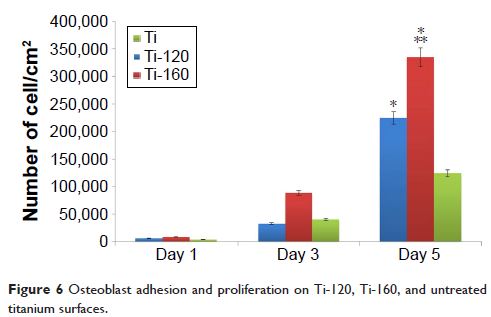9 0 5 7 8
论文已发表
注册即可获取德孚的最新动态
IF 收录期刊
- 2.6 Breast Cancer (Dove Med Press)
- 3.9 Clin Epidemiol
- 3.3 Cancer Manag Res
- 3.9 Infect Drug Resist
- 3.6 Clin Interv Aging
- 4.8 Drug Des Dev Ther
- 2.8 Int J Chronic Obstr
- 8.0 Int J Nanomed
- 2.3 Int J Women's Health
- 3.2 Neuropsych Dis Treat
- 4.0 OncoTargets Ther
- 2.2 Patient Prefer Adher
- 2.8 Ther Clin Risk Manag
- 2.7 J Pain Res
- 3.3 Diabet Metab Synd Ob
- 4.3 Psychol Res Behav Ma
- 3.4 Nat Sci Sleep
- 1.9 Pharmgenomics Pers Med
- 3.5 Risk Manag Healthc Policy
- 4.5 J Inflamm Res
- 2.3 Int J Gen Med
- 4.1 J Hepatocell Carcinoma
- 3.2 J Asthma Allergy
- 2.3 Clin Cosmet Investig Dermatol
- 3.3 J Multidiscip Healthc

Reduced bacterial growth and increased osteoblast proliferation on titanium with a nanophase TiO2 surface treatment
Authors Bhardwaj G, Webster TJ
Received 30 June 2016
Accepted for publication 24 September 2016
Published 6 January 2017 Volume 2017:12 Pages 363—369
DOI https://doi.org/10.2147/IJN.S116105
Checked for plagiarism Yes
Review by Single-blind
Peer reviewers approved by Dr Akshita Wason
Peer reviewer comments 2
Editor who approved publication: Professor Carlos Rinaldi
Background: The attachment and initial growth of bacteria on an implant surface
dictates the progression of infection. Treatment often requires aggressive
antibiotic use, which does not always work. To overcome the difficulties faced
in systemic and local antibiotic delivery, scientists have forayed into using
alternative techniques, which includes implant surface modifications that
prevent initial bacterial adhesion, foreign body formation, and may offer a
controlled inflammatory response.
Objective: The current study focused on using electrophoretic deposition to treat
titanium with a nanophase titanium dioxide surface texture to reduce bacterial
adhesion and growth. Two distinct nanotopographies were analyzed, Ti-160, an
antimicrobial surface designed to greatly reduce bacterial colonization, and
Ti-120, an antimicrobial surface with a topography that upregulates osteoblast
activity while reducing bacterial colonization; the number following Ti in the
nomenclature represents the atomic force microscopy root-mean-square roughness
value in nanometers.
Results: There was a 95.6% reduction in Staphylococcus aureus (gram-positive
bacteria) for the Ti-160-treated surfaces compared to the untreated titanium
alloy controls. There was a 90.2% reduction in Pseudomonas aeruginosa (gram-negative bacteria) on
Ti-160-treated surfaces compared to controls. For ampicillin-resistant Escherichia coli ,
there was an 81.1% reduction on the Ti-160-treated surfaces compared to
controls. Similarly for surfaces treated with Ti-120, there was an 86.8%
reduction in S. aureus , an 82.1% reduction in P. aeruginosa , and
a 48.6% reduction in ampicillin-resistant E. coli. The Ti-120
also displayed a 120.7% increase at day 3 and a 168.7% increase at day 5 of
osteoblast proliferation over standard titanium alloy control surfaces.
Conclusion: Compared to untreated surfaces, Ti-160-treated titanium surfaces
demonstrated a statistically significant 1 log reduction in S. aureus and P. aeruginosa ,
whereas Ti-120 provided an additional increase in osteoblast proliferation for
up to 5 days, criteria, which should be further studied for a wide range
of orthopedic applications.
Keywords: nanotopography, infection, titanium dioxide, electrophoretic deposition
